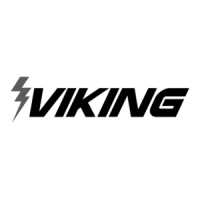ing through valves #4 and #6. This is normal as the bladder expands within the shell. Allow enough time to fill
bladder volume with air. Once the bladder has expanded out against the shell, air pressure will begin to build.
7. After reaching the specified pressure, close the air isolation valve on the air test equipment, trapping air within the
bladder. Pressure should maintain if there are no holes in the bladder. Pressure may drop several ounces. If
so, open the air isolation valve, raising the pressure back to the starting point.
8. If no significant drop in pressure occurs, remove the airline and carefully release air from bladder.
9. If air pressure cannot be maintained within the bladder, please call Viking at 877-384-5464.
The above test is best performed with the foam concentrate drained from the bladder. Since most damage occurs in the
upper portions of the bladder, this test will work with the bladder partially filled with concentrate. While draining water from
the shell, observe closely to determine if a large quantity of AFFF is present. If this is the case, you may need to contain
this solution rather than running it directly down a drain.
19

